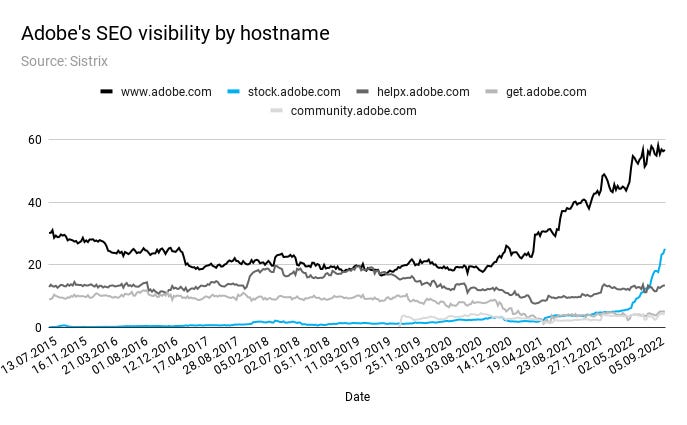How Adobe unlocked new SEO Growth
In this Growth Memo, I explain how Adobe unlocked new organic Growth after a period of flat traffic.
Adobe is an outstanding example of a business strategy pivot. In 2011, they announced Creative Cloud, a subscription offering that resulted in a 200x multiplication of their stock value over 10 years.
But that’s not the only Adobe success story.
After a long period of flat organic traffic, Adobe’s unbranded organic traffic almost doubled from 10 to 18 million monthly visits (US) over 12 months because of a strategic decision.
In this post, I explain Adobe’s core SEO strategy and how they unlocked new growth.
Adobe’s integrator strategy: content hubs, tools, international expansion
Adobe offers a suite of tools in the creative, e-signature, marketing, and commerce space that they sell directly to customers. That makes them perfectly suited for a classic integrator SEO strategy.
Adobe has content hubs for every product with use cases, tutorials, landing pages, and tips. This focused (you could say “siloed”) content structure stands opposed to putting all the content on a blog where it’s sorted by time. Hubs lend themselves much more to strong Topical Authority, but also a much smoother user experience. All relevant information is close together, every piece of information is related.
The /acrobat content hub, for example, houses over 850 pages of landing pages, blog articles, tutorials, etc., and drives 1.9 non-branded monthly visits - just from SEO in the US alone.
Part of the content hubs but a separate strategy in my mind are the sets of simple tools Adobe built. Just the /acrobat hub alone has ~25 simple applications that solve basic problems like “rotating a PDF” and target juicy keywords. Just the search term “Pdf to word” is searched for over 200,000 a month in the US.
To use those tools, users must sign up, which funnels them into email campaigns and drives potential customers.
Even though the US is Adobe’s largest market, most traffic comes from India (21% compared to 20% in the US). Almost 5% comes from Brazil and 3.5% from the Philippines. Globally, Adobe gets 135M monthly visits from SEO (compared to 4M from paid).
One important advantage of integrators with multiple products is their potential to bundle them into one super offering. Adobe’s bundle, Creative Cloud, gives users get access to a set of tools for $9.99 - $19.99 or all of them for $54.99, including fonts, stock photos, etc. The pricing strategy makes upselling very attractive. Customers can either pay $19.99 for Photoshop or pay $30 more per month and get access to all tools. For most users, that’s a no brainer.
As a result, the value of a sign-up for a single tool exceeds the tool’s price because it can lead to a conversion to the Creative Cloud bundle. In other words, companies with a bundle have a larger potential customer lifetime value, raising the value of SEO (and every other channel for that reason).
Unlocking new growth with an aggregator strategy
The biggest unlock of recent SEO Growth came from a new aggregator strategy. On stock.adobe.com, users find photos, vectors, videos, fonts, plugins, and more to use with Creative Cloud products. The hub already drives over 10M monthly visitors just in the US.
In record time, Adobe’s stock subdomain traffic passed competitors like Shutterstock or Istockphoto.
This is where the Creative Cloud bundle once again impacts the SEO strategy: customers get access to a standard license and can use all assets for free, while non-customers have to pay extra. For example, the license for a simple vector quickly reaches $79.99 - more than a monthly Creative Cloud subscription.
10 years ago, Adobe bought the graphic designer community Behance, which is alive and thriving. The UGC aggregator play is similar to stock.adobe.com because it’s also contributor driven. The difference is that artists can make money on Adobe Stock. On Behance, creators can get visibility, a following, and potential leads.
Adobe has built a smart Growth loop around these assets: artists can use Adobe tools and offer their work for sale on stock.adobe.com. The assets on stock.adobe.com rank in organic search and acquire new Creative Cloud customers. A win-win.
Conclusion: staying ahead of Canva
Adobe’s $20B acquisition of Figma is a strategic leap to own the work that happens before designers get to work: mockups, specs, UX requirements, brainstorming and prototyping. Figma is an SEO integrator that built an SEO aggregator play by surfacing and ranking with community templates on their website.
Often thought to be Adobe’s main competitor, Figma’s product is actually complementary to Adobe. The real competitor is Australian wonder startup Canva.
Canva is also known for its strong SEO strategy but hasn’t yet figured out an aggregator play. A UGC-based graphic asset play might be a good idea, but also a copy/paste version of Adobe’s strategy. That’s the benefit of (SEO) aggregator strategies - they build strong moats.
The long-term question that affects both companies is how AI tech like DALL-E could change the product and graphical asset landscape. Microsoft will use DALL-E in its coming Designer product - a direct Canva competitor. Image-generation AI has the potential to severely undermine the value of stock image platforms. It will be interesting to watch whether Adobe can pivot once again.








